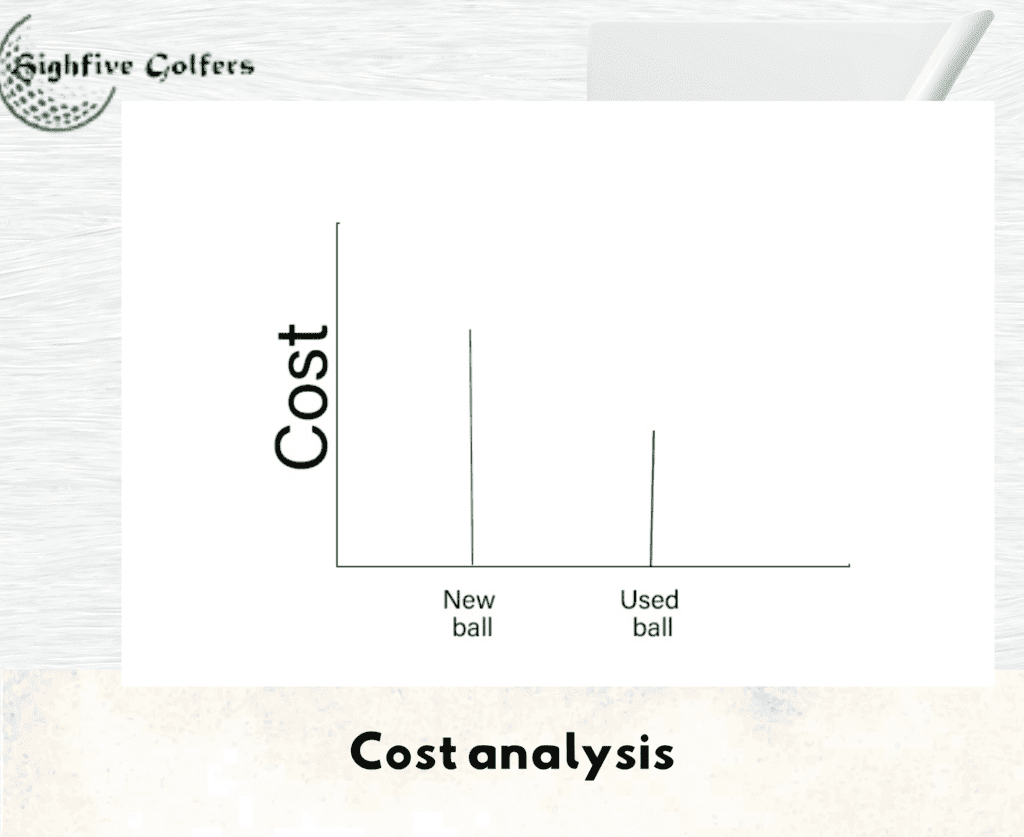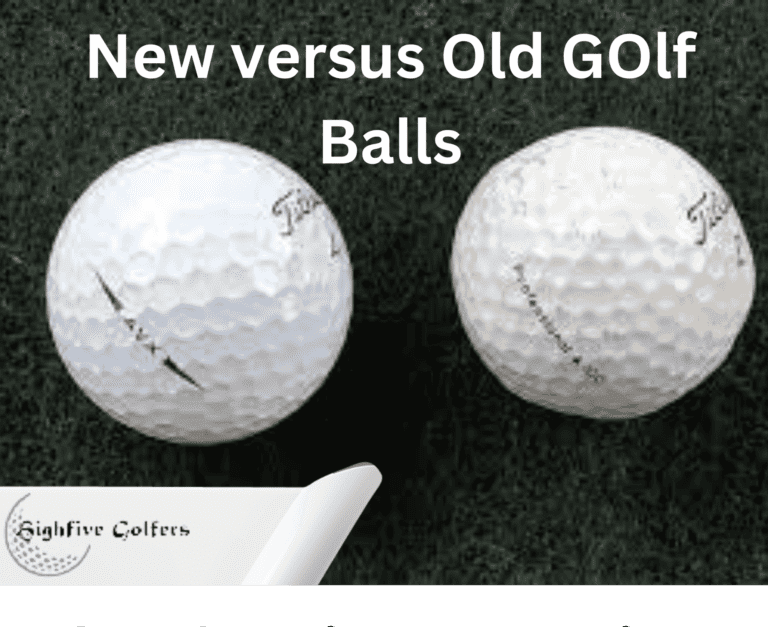Comparison of new and old Golf balls can be difficult, as many aspects need to be taken into account. Whether it’s a distance, spin rates, or feel and control – all these can help improve your skills on the field. Therefore, in this guide we’ve put together a comprehensive comparison of new versus old golf balls. This comparison is based on a detailed analysis of their accuracy, durability, and performance features. So, whether you are a professional golfer or just starting the game, this article will prove useful in making your decision easier.
Comparison of New and Old Golf Balls:
Here, we will compare new and used golf balls. Besides, we will also explore the differences that can impact a golfer’s experience on the course.
Comparison chart
|
Aspect |
New ball | Used ball |
|---|---|---|
|
Distance |
Cover more distance |
Coverless distance |
|
Spin rates |
optimal spin rate |
offer satisfactory spin rates if they are in good condition |
|
Accuracy analysis |
utmost accuracy |
slight deviation in accuracy |
|
Feel and control |
often associated with a superior feel and control |
slightly different feel compared to new |
|
Driver performance |
More drive distance |
Less drive distance |
|
Iron play differences |
perform more consistently when hit with an iron |
inconsistencies in iron play |
|
Short game impact |
provide an exceptional feel and control during short game shots |
showcase a slight variation in short game performance |
|
Wind resistance |
more stable flight, even during gusty winds |
Gusty weather slightly impact their flight |
|
Consistency over time |
maintain their good performance for a longer period |
gradual decline in their performance characteristics |
|
Cost |
Have more cost |
Low cost |
| Environmental impacts |
More | Less |
Spin rates
Regarding spin rates, both new and used golf balls can show variations.
- new golf balls often provide an optimal spin rate due to their untouched condition. However, the spin rate can be affected by the type of ball, the dimple pattern, and even the golf club used.
- On the other hand, used balls can still offer satisfactory spin rates if they are in good condition. The wear and tear on used balls might alter the dimple pattern, leading to changes in the spin rate. Hence, this changed spin rate might affect the flight path and the ball’s behavior on landing.
Accuracy analysis
Regarding accuracy, both new and used golf balls can exhibit varying results.
- New golf balls, being in perfect condition, are typically designed to deliver the utmost accuracy. Their perfect spherical shape, uniform weight distribution, and undamaged surface allow for a straight and accurate flight path when hit correctly.
- In contrast, used golf balls may show a slight deviation in accuracy, primarily if they have been subjected to extensive wear and tear. The alteration in dimple pattern due to use can influence the ball’s trajectory and, hence, its accuracy.
Feel and control
The feel and control of a golf ball significantly influence a golfer’s performance.
- New golf balls, due to their fresh-out-of-the-box condition, are often associated with a superior feel and control. This excellent feel and control is largely due to the outer layer and perfect dimple pattern.
- Alternatively, used golf balls, depending on their condition, may have a slightly different feel. The wear and tear they have faced could affect the surface texture and, subsequently, the control of a player on the ball. However, many golfers argue that with used balls in good shape, the difference in feel and control compared to new balls is small.
Drive performance
Analyzing the drive performance of golf balls can provide insightful findings.
- New golf balls are manufactured with the latest technologies to enhance drive performance. Their untouched condition, perfect roundness, and consistent weight distribution contribute to an optimal launch and flight. Thus maximizing the drive distance.
- Conversely, used golf balls may manifest a slight dip in drive performance, particularly if they’ve been extensively used or are in poor condition. The wear and tear might influence the launch and trajectory of the ball, thereby affecting the drive distance. Yet, many golfers find negligible differences in drive performance between new and used balls. This is especially true when the used balls are well-maintained.
Iron play differences
One can expect new and used golf balls to perform distinctively when examining iron play differences.
- Due to their perfect condition and standardized characteristics, new golf balls will likely perform more consistently when hit with an iron. Their unworn surface and intact dimple pattern can contribute to optimal spin, distance, and control with iron shots.
- In contrast, used golf balls may display inconsistencies in iron play due to the potential alterations in their surface characteristics. The damage on used balls could affect their spin and control when hit with an iron. This damage leads to possible differences in accuracy and distance. However, many golf players find the differences in iron play between new and used balls negligible. It is in a condition that used balls are in decent shape.
Distance
Distance is a significant factor when comparing new and used golf balls.
- New balls are often in perfect condition and have not been exposed to any elements that could compromise their performance. Therefore, they’re expected to provide the maximum distance when struck correctly.
- However, used balls, depending on their condition, can be just as effective. Many golfers have reported that they see no noticeable difference in the distance they can achieve with a used ball compared to a new one.

Short game impact
The short-game impact of golf balls can vary between new and used ones.
- New golf balls, being in their original condition, can provide an exceptional feel and control during short game shots such as putting, chipping, and pitching. The uniform surface and unbroken dimple pattern can translate into greater spin control and consistent performance.
- On the flip side, used golf balls might showcase a slight variation in short-game performance, primarily due to their worn condition. The overused old balls could alter the surface texture and dimple pattern. This influences the ball’s behavior during short game shots.
Putting characteristics
When discussing putting characteristics, it is crucial to consider the differences between new and used golf balls.
- New golf balls are often favored for their predictability and consistency on the greens. The fresh condition, uniformity of their surface, and unharmed dimple pattern can contribute to a better roll, providing golfers with enhanced feel and control during putting.
- Conversely, used golf balls, depending on their condition, might behave slightly differently on the greens. Erosion could potentially impact the ball’s roll, influencing the putting distance and direction.
Wind resistance
When considering the wind resistance of golf balls, one should consider how the ball’s condition can impact its flight in windy conditions.
- New golf balls, fresh from the box, are designed to have optimal aerodynamics due to their unworn surface and perfect dimple pattern. This design allows for a more stable flight path, even when facing gusty winds.
- Used golf balls, on the other hand, might have their aerodynamics subtly altered due to scratches. The surface changes could affect the ball’s ability to withstand and sail through the wind, slightly impacting its flight path.
Consistency over time
Consistency over time is another factor where new and used golf balls differ.
- New golf balls generally maintain their performance characteristics for a longer period. The unbroken dimple pattern and undamaged surface ensure that the balls perform consistently over time, providing predictable ball behavior.
- Conversely, the performance of used golf balls can vary over time, depending on the level of damage they have undergone. Used balls might gradually decline performance characteristics due to the wear on their surface and changes in the dimple pattern.
Cost:
When evaluating the cost aspect of new golf balls versus used golf balls, it becomes evident that they offer a substantial cost advantage.
- New golf balls offering consistent performance are priced higher. They are an investment for golfers who want to ensure the best performance and are willing to bear the cost.
- On the other hand, used golf balls provide a cost-effective alternative, especially for casual players or those on a budget. Although they may show signs of wear, these old golf balls sometimes perform similarly to new balls. Thus, used golf balls represent a budget-friendly option that allows golfers to enjoy the game without a significant financial outlay

Environmental impacts:
In examining the environmental impacts, one must recognize that the production of new balls contributes significantly to the carbon footprint.
- The manufacturing process of new golf balls involves using raw materials, energy consumption, and CO2 emissions, all of which have a substantial environmental impact. Additionally, the packaging and transportation of new balls add to their carbon footprint.
- Conversely, used golf balls present a more eco-friendly alternative as their reuse reduces the need for new production, thus saving resources and reducing carbon emissions. Even though their lifespan might be shorter, the environmental cost per round of golf is lower when using used balls.
Conclusion:
In conclusion, the right golf ball for you depends on your playing style, preferences, and goals on the course. With different constructions (resulting in various flight paths and spin rates), you must ensure that your golf ball delivers performance according to your game. Research and take advantage of our comparison chart above to help you get the most out of your golf ball.
Frequently Asked Questions
What is the difference between new and old golf balls?
- New golf balls are those that have never been played with before. Old golf balls have been used in a game or practice session.
- The main differences between the two can be seen in their appearance and performance.
Why should I choose new golf balls over old ones?
New golf balls may be a better choice for your game for several reasons.
- First, new golf balls have a smoother and more consistent surface. This allows better control and accuracy during shots.
- Secondly, new golf balls have not been subjected to the wear and tear of repeated play. It means that they maintain their original characteristics for a longer time.
- Lastly, newer golf ball models often incorporate new technologies and designs that can enhance your game.
Can old golf balls still be used in a game?
Yes, old golf balls can still be used in a game. But their performance may not be as reliable as newer ones. As golf balls are used, they tend to lose their original characteristics, such as spin and distance control. Thus, it can affect the outcome of your shots and your overall game. Using as many new golf balls as possible is always recommended for optimal performance.
What are the benefits of using old golf balls?
Of course, using golf balls also has some benefits. Benefits like
- For starters, used golf balls can be significantly cheaper than new ones. This can be beneficial for beginners or recreational players. These people do not want to invest too much money in equipment.
- Additionally, some golfers believe that used golf balls have a better feel and control on the greens, as they have been “broken in” compared to new ones.













